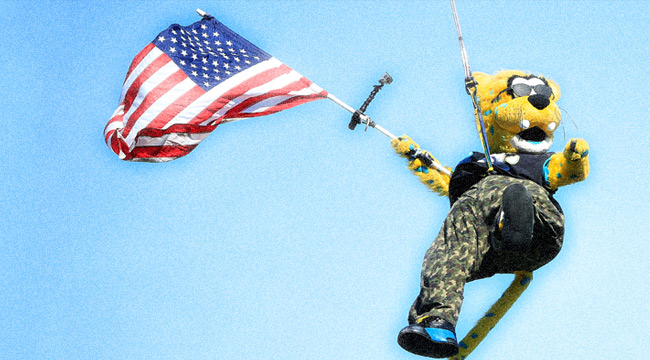
Getting into the mascot business is different for everybody. For me, it started with a call from my boss that ended with “oh by the way, you’re going to be wearing skates.”
Having your phone ring when you already wasted all your brainpower on four whole days of classes that week (bless Business Schools that eschew Friday classes completely) and haven’t even shaken off the Thirsty Thursday hangover yet, receiving the last-minute word on Friday that there was a job waiting for you the next day isn’t the most exciting prospect. The only reaction is to roll back over, mumble into the phone that you’ll be there on time, and pray to whatever higher being is out there that no small children are harmed in the making of this backup mascot experiment.
It was the only one in my college office who had the right height, weight, build, and enthusiasm (mostly) to serve as a backup when the full-time guys couldn’t come through for random events that didn’t involve an actual game. These overflow gigs are the perfect opportunity for an aspiring mascot to jump into the industry or for an unsuspecting student to be bribed into the job. As someone who isn’t a long-time aspiring mascot, you might just get a call first thing on a Friday morning telling you that the school’s marketing department needs a backup mascot the next day.
Fortunately, no young girls innocently attending a women’s hockey team workshop were injured or permanently frightened by a human-sized Husky that weekend. I’m a lifelong skater, but not even endless practice was enough to prepare me for the tall task of balancing, changing directions, and varying speed in a bulky mascot costume. That’s not even taking into account that when you are in a suit you generally see out of the mouth, not the eyes, which means that you are either tilting your head at an unnatural-looking angle to see people at eye level or staring at your own feet for a lot of the time.
Nobody was in danger the next time I got thrown into the suit either, unless you count my own tendons feeling like they were going to fall off due to excessive autograph signings. Drawing a hundred-odd paw prints while simultaneously trying to learn how to hold a pen anew is only one of the many things people don’t tell you about the flip side of being a mascot.
One thing’s for sure, once you’ve got the mascot bug it’s hard to turn back.
—
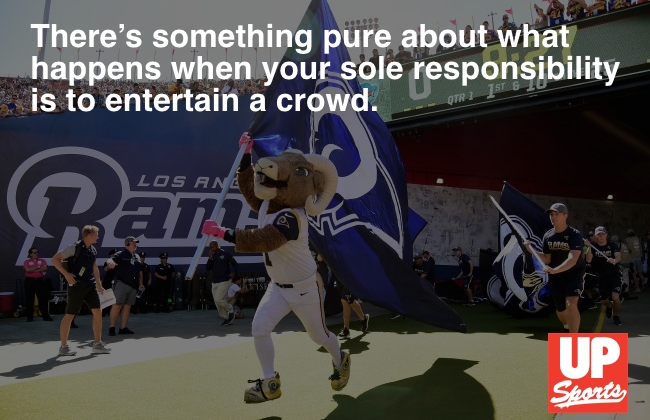
There’s something pure about what happens when your sole responsibility is to entertain a crowd. Being in a mascot suit allows you to see things that nobody else sees, or even better, something everybody else might see but in an entirely new perspective.
Any random fan walking along a concourse might get annoyed by a small child running past that doesn’t realize how disruptive they are being in public. But from a mascot’s point of view, that child is a ball of pure energy – one that is lit up entirely by the idea of a large animal getting ready to hug them, goof off with them, and take a picture to remember the moment. You get to be a part of special announcements like marriage proposals, gender reveals, or pregnancy announcements in the stands.
One current NFL mascot we spoke to, Sean (*names have been changed to protect the furry), knew that being a mascot was his calling since elementary school – the same way that other kids aspire to be a teacher or a firefighter or an airplane pilot. (Or, more appropriately, like an actor.)
Being a mascot is closer to traditional acting than many people might realize, except rather than a camera or a theatre audience, the performer is fully immersed in their audience and can interact more closely than any other traditional performer is able. They’re tasked with feeling what the “audience” is thinking, reacting to their excitement in real time, and improvising at the drop of the hat.
Anybody who has ever been to a pro sports event of any kind knows that a mascot can switch between physical humor, funny signs, and skits in the crowd depending on the mood in the stadium and the status of the game. These are skills any good comedian has in their holster, but they’re absolutely essential to be a successful mascot. Another pro mascot, Peter*, works for a soccer team down South and describes adjusting to different crowds and teams like “sports Saturday Night Live. You have to find out what’s funny, what’s relevant…and what’s edgy.”
It takes strategy about what makes a good video skit versus what plays better live, and advanced planning months ahead of time as well as anticipation of energy conservation during different moments in the game.
Sean was introduced to his future mentor at a young age, a long-time mascot still in the industry who guided him through his desired career long after their first meeting at a school event. That kind of early connection to the industry is rare, but not shocking when you consider how open and welcome to apprenticeships and feedback many people are in the relatively small family that is the mascot world. Of all the conversations we had with the men and women behind the costumes, one of the things that most stood out was by far the repeated stories of camaraderie and support found in the industry.
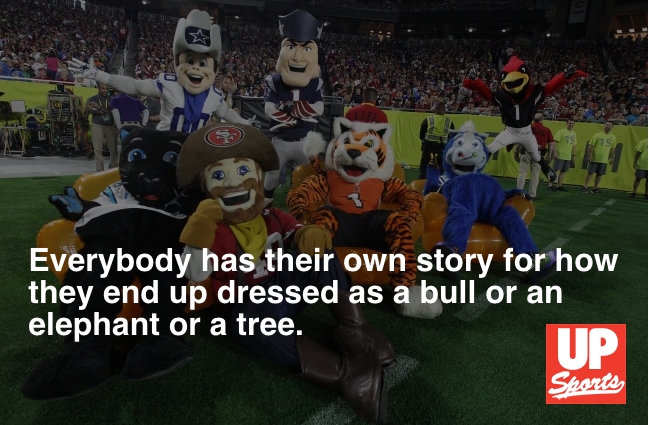
There are veteran performers who take more than a few young entrants under their wings in one way or another, and due to the tight knit nature of the world, this shouldn’t be a surprise. There are only one hundred-plus mascots between all of the big five sports in the US, so it’s like the entirety of a small high school where everybody works the same job and they just happen to be spread out over the entire United States.
Even though there are some more or less “standard” pathways to mascot stardom, everybody has their own story for how they end up dressed as a bull or an elephant or a tree. Many of them have origins in theatre. Peter’s wife saw their alma mater’s mascot during college orientation and said “well you could do that, right?” And after a round of auditioning the rest was history. Once he realized that he could continue making fans happy after school, and earn money doing it, what could have been a fun story to tell the kids ended up becoming a career plan.
No matter the entry point to the mascot world, not everybody necessarily undergoes formal training. Mike Mazzarella, the University of Maryland mascot coordinator, says that “you’re just going to have it or you’re not” when trying to get into the business for the first time.
Where Sean was fortunate to have a mentor to go to for guidance, Peter was lucky enough to attend a Houston Rockets’ halftime show once he was already firmly on the college beat. Which in turn led to the opportunity to have long-time – and recently retired after 21 years on the job – Rockets mascot Robert Boudwin coordinate a mini-mascot boot camp to pass on some of his expertise.
A lack of access to experts in the industry doesn’t leave curious mascots completely in the lurch though. An easy Google and you can be one click away from classes that promise mascot program development, acting lessons, crowd interaction, and sportsmanship training. With Higher Impact Entertainment, a company that runs a highly touted one-day mascot boot camp for just under $200, you can become a “confident professional entertainer” while also acquiring the requisite entrepreneurial skills (and even learn some mascot social media strategy).
Founded by Jerome Bartlett after a few years with the San Antonio Spurs organization and extensive time as a high school and college mascot prior to that, the company aims to fully prepare new and experienced mascots for any challenges that may arise. Bartlett says that other programs he saw involved more book reading than actual hands-on experience and that he “was lucky enough to be trained by the original coyote” and wants “to pay it forward to the next generation, because he had someone teach [him].” In high school he considered himself an ambassador to the school, not just an embodiment of a brand.
In college he was directly involved in rejuvenating the mascot program with a full backstory about the character and an overhaul of the costume. Higher Impact also sponsors a local minor league team, to provide entertainment that might not otherwise be possible for the smaller minor league crowds. All of this time and energy because being a mascot “is a passion that comes so naturally.” Because once it clicks, there’s nothing that can’t be built off the joy of being a mascot.
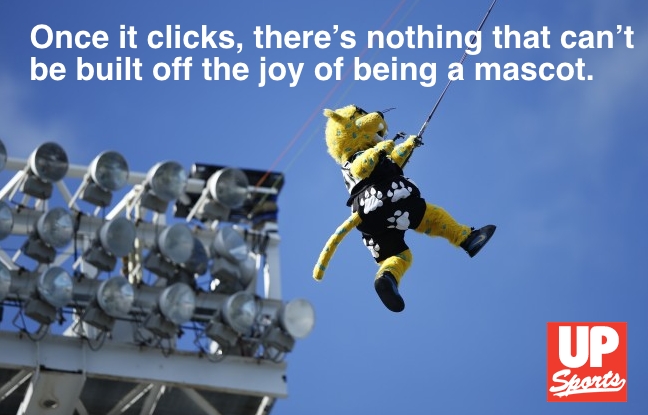
While Bartlett mostly kept his identity secret in high school, college, and the pros, that didn’t prevent him from showing off his acrobatic skills at a rollicking college party or two. Everyone has some slips of course – what’s the use of those skills if you can’t get a free beer by showing them off now and then? Jerome publicly talks about his past work freely and advises others through his business, yet mascot tradition generally frowns upon revealing your identity while still holding a job as a paid mascot. The integrity of the character sometimes depends on the audience being able to suspend their belief that someone is actually inside the suit, but more than that anonymity contributes to the effective longevity of each mascot character.
Dan Meers has been with the Kansas City Chiefs as KC Wolf for 27 years and has been participating in school programs for most of that time. His identity’s been completely out in the open. He hosts programs during which he takes his costume off and reveals his human self almost immediately after entering a room full of kids who might not even know mascots aren’t just awesome human-sized animals. Since the endgame of these visits is to teach kids about bullying, active lifestyles in line with the NFL’s Play60 program, or other important lessons, there is a positive touch to his unorthodox methods despite usually being a no-no in the job.
As soon as another person takes his place after he relinquishes his long-time gig, that person will be constantly compared to what Meers did during his time as the Wolf, a character he originated. It’s a risk that some mascots are willing to take, and others are worried that it will compromise the character. The common concern is that it is unfair to the eventual replacement to already be behind the eight ball in the costume if they constantly have to measure up to somebody they never knew or worked with.
The importance of character consistency is so key that some teams will study tape on the way a prior mascot walked or motioned during to pass along the same habits to the next person in the suit. While there can be gradual changes from one person to the next (sometimes necessary ones based on how the sport or society changes across eras), the goal is for there still to be a strong line in the mascot heritage so that fans know generally what to expect day in and day out. (Ideally, the Minnesota Viking won’t be fierce and intimidating one season only to exclusively do gymnastics-inspired stunts the next.)
Sean’s transition a little over a year ago from an in-state hockey team to the team he currently works for involved a “softening” of the football mascot, one that added some school programs similar to Meers’ but didn’t remove the bulk of the ferocity and energy that gets fans involved every Sunday.
Now that teams are embracing social media across the board though, mascot anonymity and the protocols about talking to fans aren’t such hurdles anymore. Mascots are able to communicate and have a personality with fans even when there isn’t an official community event or game scheduled that day. It’s also another way to promote events and games in the mascot’s own voice, rather than just in straightforward and sometimes unemotional advertising speak.
“As a billboard, mascots can access areas that most billboards cannot” Bartlett says, “They’re front and center and they’re funny and it makes the team look even better.“
—
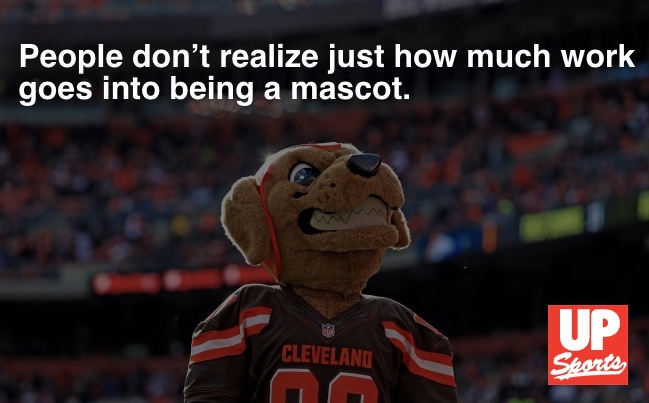
With the rise of Twitter and Facebook use in the sports world in recent years the skills that most mascots require for their core responsibilities can be translated into mascot’s words for the first time. A prime example of this is Bailey, the LA Kings mascot, who will just as quickly lob a gentle insult at a reporter or fan as he will applaud the team for a great win. One source we spoke to confirmed that the guy behind Bailey is just as funny out of the suit as he is in it, an attribute that is becoming more and more important as a team’s public outreach and social media efforts begin to overlap.
While it’s unlikely that Bailey tweets out everything himself, it is still another level of the character to consider in everything the mascot and the team does, layering the mascot for fans as more than just a mute cheerleader that shows up around the city and rallies the crowd during timeouts. Social media has also spurred the side effect of improving every mascot around the country because everybody can now look up what other mascots are doing or trying and see if they can one-up another skit or bit creatively.
Maybe the most misunderstood thing about the job is that mascots do far more than just work games and then go home and sit on the couch with a cold one to watch 24 reruns. The one thing we heard most from mascots currently in the business at the collegiate and pro levels is that people don’t realize just how much work goes into being a mascot and maintaining the peripheral responsibilities of the job.
In college, Bartlett spent his own spare time working on a stable of skills that he would use for years to come – things like juggling, dancing, and learning how to ride a unicycle. Mazzarella, once Maryland’s Testudo himself during his college days, is committed to mentoring the college kids currently serving as the mascots on top of his usual scheduling, event planning, and game monitoring. Sean recently worked a week straight of 16-hour days and considered that normal. And that’s not even including game day.
A single day in the life of this one mascot could consist of multiple school visits, each of which consists of multiple hours of traveling and interacting with young kids. Then, after what would be considered a full workday for many others, there are still dozens of emails to answer about other event requests and administrative needs, followed by an hour or more at the gym to stay in shape and make sure the suit actually fits day after day. There’s also budgeting, marketing plans, and prop planning behind the scenes.
That doesn’t even take into account balancing normal life with all that being a mascot entails, how to manage kids when you might have an early Sunday morning event, or figuring out how to take a proper vacation if there are upwards of 300 ancillary community events to appear at throughout the year on top of games. Yes, teams have backup mascots, and yes, these hours are no better or worse than many other common jobs in the United States, but there’s the assumption that mascots don’t work hard once the clock hits zero and the fans pull out of the parking lot. Sure, mascots have fun (and they will be the first to admit that), but it’s a lot more than just “acting like an idiot in the middle of a game.”
For all their efforts, mascots take home a decent paycheck – with some truly hitting the jackpot if they transcend the sidelines and become a full-fledged “brand.” Base pay for a professional mascot is around $55,000, according to comments made by Dave Raymond, the former Philly Phanatic, in 2015. In most situations there are incentives on top of that depending on additional event appearances, the overall value a mascot is bringing to a team, and whether or not the mascot is popular enough to create it’s own revenue stream. Think of Wally the Green Monster getting his own Christmas ornaments, or a mascot so valued by the community that the team can add revenue by putting the character in local commercials instead of using their players. The best and most famous mascots in the business can take home six figures easily with all of the work they do outside of games or the actual season. Even part timers can become popular enough to pull in a few grand a game, which is nothing to scoff at either.
As Sean puts it, “it’s a real profession, it is a full time job. It’s a value-generating department.”
—
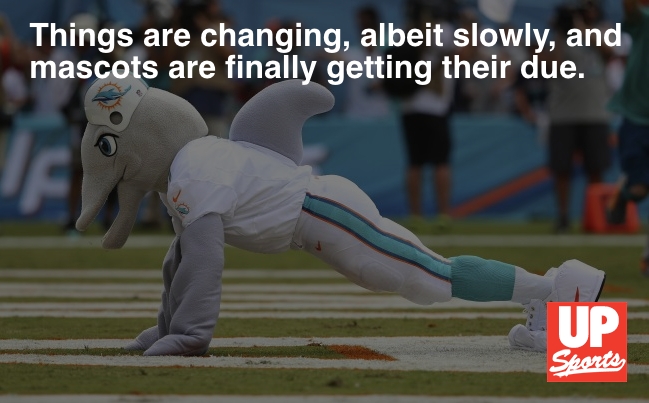
They may be a value-generating department in real life, but in pop culture, mascots have long been the bumbling clutzes on the side of the court or field. Often, they are the comic relief at the hands of a main character – fumbling around during a game or being hit by a hilariously errant ball. Mascot injuries are the go-to easy joke in comedies. Just this week, a new Amazon commercial for Alexa featured an uncoordinated mascot, and the most recent episode of New Girl featured a moment where the lead character Jess runs over a high school mascot in her slapstick sprint through a school.
Things are changing, albeit slowly, and mascots are finally getting their due. Hulu’s Behind the Mask allowed fans to understand additional details of what the job entails. Thanks to more instances of well-produced video skits and well-thought out running jokes or bets between opposing mascots, there are more hints than ever that time, energy, and a whole lot of creativity goes into daily mascot operations.
Then there’s Christopher Guest’s latest movie, appropriately titled Mascots. This might be the biggest step in the right direction towards representing mascots realistically on screen we’ve ever seen, even if it is filtered through Guest’s unique lens. The movie, which takes place at the a competition similar to one that was once held in Las Vegas (which Bartlett won and Peter competed in), has moments of intense accuracy mixed with some condescending character work and humor.
Each character in the movie, especially sisters Cindi and Laci Babineaux who each portray Alvin the Armadillo at one point in the movie, are portrayed as rural idiots who incorporate roadkill imagery into their routines and didn’t know they were actually half sisters until they were 16 years old. There’s a “Jack the Plumber” character that adds an anthropomorphic piece of poop to his act on the advice of his coach (the always welcome Fred Willard).
There’s a sense of Guest not really knowing where to find the humor in this line of work if it isn’t rooted in a negative opinion of mascots and dumbing down of the people who wear the suits. When Bartlett first saw the trailer for the movie he says he thought to himself “yeah, there’s people like that who exist in the mascot world.” And while that rings true in the way that Mascots allows for unorthodox animals or mascot choices to appear (an octopus/turtle duo that also happen to be a seriously unhappy married couple, or a Rabbi and worm dance team), it doesn’t have much respect for the people behind the mask.
Mazzarella thinks anything that normal people do is “significantly” funnier if they are wearing a mascot suit, like the time he and some other college mascots did a Chinese Fire Drill in full costume or like when Owen Golly, Jr. gets pulled over by a cop in his squirrel suit in the film. It would be better if the humor from Owen’s run in with the police could stem from that cop/mascot dynamic instead of a case of his previously unmentioned “police Tourette’s.”
The skill it takes to plan a competitive performance is present, as are the interlocking relationships that come with mascots overlapping at similar events year after year, but the motivation of each competitor is rooted in some sort of personal failing they are trying to overcome or a pathetic sense that this is the only thing they have to wake them up every day after another path didn’t pan out, not the magic that happens when you put the suit on. There is a blanket of melancholy over the entire film that isn’t present when watching mascots normally in real life or hearing them talk about their work.
Part of this is about standard for a Guest film, but there isn’t enough accuracy to make using mascots as his parody focus work completely. Bartlett says his favorite part of the job is being a “part of the team” in this way and getting to be a part of the moments that nobody else would see otherwise, yet in Mascots the one glimpse the audience sees of a mascot saying hello to his team is a sad look at rude teenagers and a socially awkward adult. Hilarity can come in joyful moments too, but the movie has little interest in such an approach.
Being a mascot is a tough gig, and there are sides of the job that Guest’s film does touch on, especially the preparation side of things. In the scenes that take place at the mascot competition trade show, there are booths that display medical supplies for injured mascots (Zach Woods’ character opens the film with a potential knee injury), a booth advertising mascot dry cleaning, and examples of different head and body structures. Maybe the most accurate detail is how the suit smells, and ways to prevent that.
Being in the suit can be 30 degrees hotter or more than air temperatures. Which is great news if you need to stay insulated in the colder months above the Mason-Dixon Line, and terrible news if you don’t.
Peter, whose sport necessitates that he work 90-minute games with no breaks because soccer has no timeouts, fully admits he has no idea how he really makes it through those hot events every day. There is no strategy besides “pushing through.”
The best that he can describe it is that “once you get used to it, you have to keep doing it. If you get done in October and you get back in March and you haven’t been outside and haven’t actually done any strenuous mascotting you’re out of luck.” It’s the same as being a player on the team – if it’s a dumb move for them to show up at the first week of training camp without being in proper shape than the mascot can’t hack it that way either.
Some people we spoke to are incredibly lucky and cited air conditioning or a roof that closes as their saving grace on game day. Mazzarella remembers a time that he “basically almost had a heat stroke when [he] was in costume… at a 90 degree football game,” a memory that I can relate to as well.
My first and only pro turn in the suit involved a near-100 degree summer day at Fenway with Gary Sinise’s band playing in the background (yes, really) and a point where I had to be propped up against the left field concourse wall so that I didn’t face plant from dizziness in front of a bunch of screaming kids.
Even the most in shape athletes can’t really anticipate the strength, coordination, and energy needed to keep being a mascot up for more than a half an hour at a time.
—
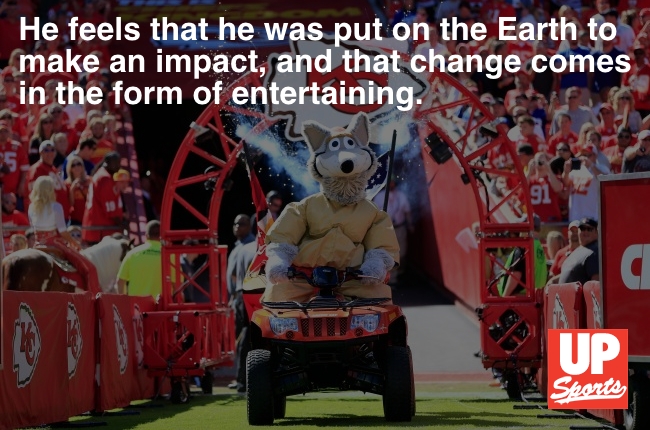
Besides the elements, mascots also have to deal with intoxicated fans trying to pull off the costume head and the ever-changing nature of the crowd every game. In 2013, Meers was involved in a horrific accident while practicing what would have been an incredible entrance into Arrowhead Stadium.
A problem with the zipline resulted in Meers falling into a section of the upper deck during a practice run, a fall that necessitated months of physical therapy and an uncertain return to the job. As a man of faith, Meers relied on that and his passion for the job to keep an eye on a possible return no matter how long it took. He feels that he was put on the Earth to make an impact, and that change comes in the form of entertaining.
With his return to the field in 2015, Meers proved that nothing could keep him away from the job. It’s not a stretch to say that his love of the job and the delight he brings the team’s devotees helped him get back to the stadium just as much as hours of rehabilitation did.
With the bad parts come the good, though, and there is more good that oozes out of the mascot community than might seem possible. Besides all of the mentors and companies that strive to improve every mascot out there just because they love the job, there is also the sense of the community itself. The same names frequently come up, all in different roles. A colleague can also be a mentor and can also be the one passing the baton to the next eager performer in line, and this can happen between people hundreds or thousands of miles away from each other. Mascots that operate all in one city have those same types of relationships, but the overlap is multiplied tenfold.
By far the best example of such mascot camaraderie I’ve ever seen came that same day at Fenway Park where I almost hit the deck due to the heat. During one of the rare segments when all four of the major Boston sports team mascots were on duty at the same time, the group was called to one of the business suites to say hello to a few of the higher ups at the company whose event it was, as well as some Red Sox players of years past. The World Series trophies from 2004 and 2007 were there, but other than entertaining the few children who had come with their parents into the private area of the event, there wasn’t much to do.
Since the mascots hadn’t spent much time together that day, everyone started to communicate as best we could in the suits and play a few games of pool. All three of the other guys there knew each other from years of working community events around the city, so it was my job to stand there as the new kid and be terrible at pool (a skill I don’t have out of a suit either).
After a few games Pat the Patriot and Lucky the Leprechaun got in the groove and set up a bit of an impromptu series of matches, with Lucky beating Pat easily a few times – not a surprise seeing as Lucky doesn’t have to wear a suit and has full use of his hands. Finally, Pat made a signal behind his back (no talking!) that clearly meant “there’s money on this one.” All of a sudden The Patriot had an incredible streak where he all but ran the table on Lucky. In his full suit and gloves.
One mascot hustling another while in a room full of a bunch of random strangers only there to take photos with their favorite team’s representative is the most hilarious mascot moment I’ve ever seen in person, and a testament to the relationships that can blossom between mascots just like it was any other office hang out.
—
Retired mascots might go in any number of directions for the rest of their working days. Boudwin is now a Marketing Consultant, Non-Traditional Brand Strategist, and speaker. Bartlett is enjoying his days as a coach and business owner, and there is now even a Mascot Hall of Fame opening in Indiana in 2017, initially conceived of as a website by Dave Raymond (who has his own business as well).
Raymond was the original Philly Phanatic and the HoF will be the first place where the people in the suit will be enshrined for all time, not just the recognition of the character. l There is also a Lifetime Achievement Award, given out only when it is deemed worthy and named after who else but Dan Meers.
The suits may stay the same until a team decides they need a change or switch cities/team names, sometimes for the worse (insert horrifying Pelican here), but now there can be a bit more recognition for the people inside – at least when they finally decide to retire.
One thing that isn’t changing as technology advances and mascots become more bold and skilled is the community. It’s hard to replicate all the solidarity that comes from a job where everybody taking part is doing for a pure and happy reason, even if they aren’t allowed to talk while they’re doing it.






